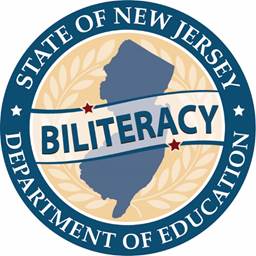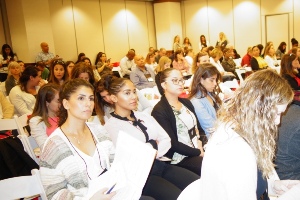NJ Teachers of English to Speakers of Other Languages/
NJ Bilingual Educators
ARTICLES
Adult Ed: Andrea S. Fonteñez- Strategies for Motivating and Engaging Adult English Language Learners
Bilingual Elementary 1-8: Jack Meyers- Unity in Diversity: How We Can Pave the Way for LGBT+ Students and Staff
Bilingual/ESL Middle School: Anel V. de Suriel- Supporting the Seal of Biliteracy in Middle School
Bilingual Secondary: Larry Bello- Proud to Be a Bilingual Student
Early Childhood: Jessica Perdomo-O’Hara- Scaffolding Strategies to Promote Comprehension of Text Read Aloud to Young English Language Learners
ESL Elementary: Andrea Pape- The Effects of Bilingual Instruction: What Does the Research Say?
ESL Secondary: Hana Prashker- Information Learned Through the Spring Conference
Higher Education: Patricia George- A Letter of Introduction from Your New Higher Education Representative
Parent and Community Action: Gabriela Colon- Getting to Know Each Other Better
Supervisors: Laura Arredondo- Teacher Advocacy: A Key to Student Engagement
Teacher Education: Lisa Rose Johnson- NJTESOL/NJBE Teacher Education Conference Reflections
Features: Summer 2019- Our Spring Conference cELLebration and Going Forward
Adult Ed SIG Representative
Strategies for Motivating and Engaging Adult English Language Learners
By Andrea S. Fonteñez, Ed.D.
 Research shows that achievement and motivation are inextricably linked. However, no single motivational pathway or type of engagement guarantees academic achievement. Each adult English language learner (ELL) is a unique blend of individual interests, backgrounds, stories, and needs. Each adult ELL is motivated in different ways at different times. According to Toshalis and Nakkula (2012), the most important factor for learning is a person’s level of effort. And it is the individual’s level of motivation that determines the intensity of the effort. The following strategies can be applied to effectively motivate adult ELLs:
Research shows that achievement and motivation are inextricably linked. However, no single motivational pathway or type of engagement guarantees academic achievement. Each adult English language learner (ELL) is a unique blend of individual interests, backgrounds, stories, and needs. Each adult ELL is motivated in different ways at different times. According to Toshalis and Nakkula (2012), the most important factor for learning is a person’s level of effort. And it is the individual’s level of motivation that determines the intensity of the effort. The following strategies can be applied to effectively motivate adult ELLs:
1) Know your Students as Learners: Effective student-centered approaches use students’ personal experiences as hooks to help them connect with the curriculum. Getting to know your students as learners is “more than merely acquiring social or administrative information—students’ names and ages, something about their friendship circles, a bit about their family backgrounds, a few statistics from their academic record.” This means getting to know your students since ELLs come from different countries and may have a different view of how educational institutions work and the role of the teacher. In order to help teachers meet the challenge of coming to know their students, Powell and Kusuma-Powell “recommend developing student learning profiles to capture five important dimensions of learning identity: biological traits, cultural and societal factors, emotional and social influences, academic performance, and learning preferences.” Collecting this information to build a learning profile for each adult English language learner will take time, but as teachers compile student data, they will get to know their students in depth.
2) Give your Students a Voice: One of the powerful tools to influence academic achievement is helping students feel they have a stake in their learning. Adults ELLs generally need to feel they have a voice in how a lesson is conducted and an impact on how it concludes. When students have a voice, it means that students are given “choice, control, challenge, and opportunities to collaborate.” (Toshalis and Nakkula, 2012). Time and again, research has shown that the more educators give their students choice, control, challenge, and opportunities for collaboration, the more their motivation and engagement are likely to rise.
3) Share the Purpose of New Learning: Students should understand why what they are learning is important and how this new learning is going to help them in the real world. In other words, students should be able to explain the purpose of the lesson and how they are linked to the theme, problem, project, or questions in the lesson. The teacher should ensure that students know the purpose of the new learning and its application beyond the classroom as well as how information can be found, used, created, or shared (Fisher and Frey, 2012) . Students need to know why they need to learn what they are being taught, how they can apply the new learning, and where the new learning fits in the larger curriculum. Finally, as Cuningham Florez and Burt stated, “ adults want their learning to be immediately applicable to their lives and need adult-appropriate content, materials, and activities that speak to their needs and interests and allow them to demonstrate their knowledge and abilities.”
4) Take into Consideration your Adult Learners’ Busy Lives: Adult learners in general are much busier than traditional students. They have jobs, families, and countless other commitments to manage. That means assignments should be convenient to complete. Small blocks of text, bullet points and numbered lists can help make content far more digestible than long readings. Some assignments can even be completed via mobile devices, so students can finish them anywhere. When teachers offer more opportunities for students to finish assignments, they are more likely to do them. (G.Duverge, 2016).
Finally, students are all very different from one another, so different factors affect their engagement and motivation in learning. A great indication of a successful teacher is one who has students who are motivated to work, participate, and obtain high levels of achievement. These four strategies to motivate and engage adult English language learners are just some of the most important strategies to promote higher academic achievement and therefore higher student academic growth.
References:
“Motivation, Engagement, and Student Voice” by Eric Toshalis and Michael J. Nakhula (2012), retrieved on 6/12/19 from https://studentsatthecenterhub.org/resource/motivation-engagement-and-student-voice/
“Six Effective Strategies for Teaching Adults” by G. Duverge, 2016 retrieved on 6/12/19 from https://online.pointpark.edu/education/strategies-for-teaching-adults/
“How to Teach Now” by William Powell and Ochan Kusuma-Powell retrieved on 6/12/19 from http://www.ascd.org/publications/books/111011/chapters/Knowing-Our-Students-as-Learners.aspx
“The Purposeful Classroom” by Douglas Fisher and Nancy Frey retrieved on 6/20/19 from http://www.ascd.org/publications/books/112007/chapters/Establishing-Purpose-for-Yourself-and-Your-Students.aspx
“Beginning to Work with Adult English Language Learners: Some Considerations” by MaryAnn Cuningham Florez and Miriam Burt retrieved on 6/20/19 from: http://www.cal.org/caela/esl_resources/digests/beginQA.html
Andrea S. Fonteñez, Ed.D. Adult Education Special Interest Group (SIG) Representative, Director of Bilingual/ESL Education, New Brunswick Public Schools,
Bilingual Elementary Special Interest Group
Unity in Diversity: How We Can Pave the Way for LGBT+ Students and Staff
By Jack Meyers
 This is an article, a memo, a letter from the heart. The issues I am about to detail hit very close to home and are of an urgent matter–to educators and students alike, as well as to the general population. Let’s start with a couple of vital and, quite frankly, alarming statistics: 1) recent studies have shown that up to 40% of homeless youth identify as LGBT+, 2) LGBT+ youth are 5 times more likely to attempt suicide than their heterosexual counterparts.
This is an article, a memo, a letter from the heart. The issues I am about to detail hit very close to home and are of an urgent matter–to educators and students alike, as well as to the general population. Let’s start with a couple of vital and, quite frankly, alarming statistics: 1) recent studies have shown that up to 40% of homeless youth identify as LGBT+, 2) LGBT+ youth are 5 times more likely to attempt suicide than their heterosexual counterparts.
Now, you may ask, what does that have to do with me, my classroom, and my instructional practice? Well, I’d be happy to explain. First and foremost, approximately 4 in every 1,000 people in the U.S. are L (Lesbian), G (Gay), B (Bisexual), or T (Transgender). That means for those of you working in school districts with several thousand students and faculty, you’ve got more LGBT+ people than you can imagine. This means that every time a homophobic slur is thrown, or a comment is made about a student choosing to use different pronouns, real lives are being harmed. Is it not our most basic duty as education professionals to make our students feel safe?
So let me tell you some steps you can take right now to make sure all of your students and colleagues feel safe and seen, and what you can do to avoid adding insult to injury for one of the most vulnerable, underrepresented, and underserved populations in our field. What we all must begin to do is cultivate literature for our students to read that authentically represents their diverse experiences. An excellent company that is embracing diversity is Lee and Low Books, a children’s book publishing company that has one of the most exemplary collection of LGBT+ literature for youth, which notably contains some hard-hitting bilingual titles. In addition, there are a whole host of critically-acclaimed books that address a variety of issues your students are probably facing, regardless of sexual orientation, gender identity, or expression.
Next up is professional development; all educators know that learning never ceases. So, in the spirit of being life-long learners, I would recommend taking notes from Scholastic’s partnership with GLSEN (Gay, Lesbian, and Straight Education Network) on how to create long-lasting, safe and inclusive spaces in our schools. GLSEN’s work is also at the forefront of promoting LGBT+ representation in learning materials. In addition, New Jersey’s own homegrown, grassroots organization, Garden State Equality, is in the midst of creating LGBT+ curricula to be used state-wide.
If you still find yourself wondering, “why does this matter? why now?” then I’d like to bring your attention to the law. New Jersey governor Phil Murphy recently approved legislation that will require all school boards to begin procuring curricula that include representation of LGBT+ people and history. If you are still not convinced of the urgency of this matter, the NJ Department of Education even published guidance on transgender students and their unique needs, which has included explicit guidelines on using students’ preferred names and gender pronouns. This is also a good point to connect LGBT+ students to our ELLs (English Language Learners), often who are immigrants, with diverse cultural experiences, and whose backgrounds, names, and histories are often ignored or erased in curricula and even at times by educators themselves.
Do you see why now is the moment to address the deeply misinformed and disproportionate discrimination of LGBT+ students and staff? If diversity is the glue that bonds us to our students and to each other, then learning across difference is the sticks, the bricks, the straw and mud that keep our foundation solid. Without embracing the unity we can and should find in diversity, we as education professionals have entirely missed the point of education. Whether that diversity is based on one’s ability to hear or see, their language, immigration status, sexual orientation, gender, nationality, or ethnicity, we need to start seeing better and more representation of diverse peoples and stories in our classrooms.
May you, reader, start that change today. Take a small step. Affirm identities with a read-aloud from one of the above-mentioned book lists; put a “Safe Space” sticker on your classroom or office door; wear a rainbow pin on your lanyard. Do whatever you are ready to do. Just do something. Your students’ and colleagues’ well-being depends on it.
Jack Meyers is the Bilingual Elementary SIG Representative and a 3rd Grade Bilingual Teacher in Franklin Twp. (Somerset County). He can be contacted at jmeyers@njtesol-njbe.org
Middle School ESL and Bilingual Special Interest Group
Supporting the Seal of Biliteracy in Middle School
Anel V. Suriel
 During the Seal of Biliteracy Symposium at this year’s annual NJTESOL/ NJBE conference, attendees heard the same message repeated: the road to biliteracy must begin at an early age, well before the designated junior year of high school testing window.
During the Seal of Biliteracy Symposium at this year’s annual NJTESOL/ NJBE conference, attendees heard the same message repeated: the road to biliteracy must begin at an early age, well before the designated junior year of high school testing window.
As it exists, the task of identifying, tracking, and testing for biliteracy seems to rest on the high school educator. However, this effort can start as early as fourth and fifth grade with special attention at middle school.
Middle school educators can support students who may qualify for the seal via early identification, creating early awareness amongst students and families, and by helping foster home language literacy practices via language portfolios.
Creating Awareness Amongst Students and Families Knowledge is power. The more teachers, building leaders, district superintendents, students, and families know, the better they can advocate for the Seal of Biliteracy.
Introduce students and families to the Seal of Biliteracy at Back to School night and Parent-Teacher Conferences at school level as well as in world language, English as a Second Language (ESL), and bilingual education classrooms. Students can create short and long-term goals for both home language and English language development with guidance and reminders from classroom teachers. Students should be provided opportunities to grow and reflect upon emerging bilingual identities and should be exposed to multilingual texts that reflect the same during literacy instruction.
Discuss individual progress toward home language development and bilingualism during conferences and family check-in times. How are students keeping on track to obtaining the seal in high school? Encourage families to learn about the benefits of home language using supportive organizations like Colorín Colorado (2019) and the Speak Your Language Campaign.
Keep information accessible in a variety of languages to foster community support. Multilingual banners and classroom mottos can create student and family support of home language learning. Keep them visible to all members of school buildings to encourage conversation about and interest in the Seal of Biliteracy.
Celebrate progress in home language literacies. Bring in families and community partners to encourage and foster home language growth alongside English language development. Create classroom, school and/ or district based initiatives, end-of-year certificates and or celebrations that recognize growth in all languages equally.
Early Identification As discussed during the Symposium, as compared to world-language learning peers, significantly few English Language Learners (ELLs) and former ELLs obtain the Seal of Biliteracy. One reason may lie in the time and effort it takes to identify potential candidates amongst ELLs who have exited bilingual and ESL programs in the years preceding high school.
The identification process can begin as early as the upper elementary grades, and monitoring should continue in the middle level years by the teachers who service these multilingual ELLs.
Identify students already learning in bilingual programs and entering schools with home language literacies. If bilingual or ELL programs students can be easily coded and monitored within existing district-wide data systems, it will be invaluable to the high school level educator called upon to identify candidates for language testing. However, creating a shared Google Sheets page, ‘Seal of Biliteracy’ file, or placing a visible marker on ELL files that travel across schools upon promotion can also be a solution to keeping track of students who may be eligible for the Seal in high school.
Gather and track student progress toward bilingualism. Students who are learning in their home languages via bilingual programs during middle school should be marked for potential eligibility for the Seal. Monitor growth in home language reading, writing and oracy levels alongside English language data via already established district assessments. This data may include, and should not be limited to, formative reading level assessments (i.e., running records), processed writing levels across narrative, argumentative and informational genres, oral and digital assessments, as well as on-demand and end of unit literacy assessments given in home or target languages or are translanguaged for emergent bilingual students (García, 2012; Mahoney, 2017)
Create methods of sharing data between intermediate and secondary schools. Designate a point person(s) for receiving and continued monitoring of data for potential candidates at each school level. Cloud storage methods such as Google Sheets or uploads to district wide student data programs can also facilitate data sharing amongst schools and stakeholders.
Allow families to opt-in. Family interest and support can also help identify future candidates. Signed support and interested statements alongside growth monitoring forms for home language development can also keep teachers, students, and families focused on the goal of biliteracy across classrooms and schools.
Home Language Literacy Portfolios Evaluations and assessments of bilingualism must be founded on the premise that home language skills are an asset. A language portfolio that tracks student’s linguistic growth of time can support the legislative mandate for students to demonstrate proficiency across multiple methods (NJ State Seal of Biliteracy of 2016) while monitoring students’ progression toward the Seal of Biliteracy.
Collaborate and calibrate across grade levels. Bring together language educators across bilingual and or foreign language programs (for those languages supported by school based programs) as well as family and community members who can provide insight into the traditions of minority languages. These committees can select and execute pedagogical practices such as translanguaging (García, 2012), create Biliteracy Unit Frameworks (Center for Teaching for Biliteracy, 2018), and employ programs such as Dr. Kate Escamilla’s, et al, Literacy Squared (NEPC, 2019) that are proven to support bilingualism and biliteracy. The committee can also evaluate home language portfolios for language development and growth.
Select practical and appropriate assessment methods and tools. For the home language portfolio to be effective, it must be practical for the language teacher. Students artifacts can be drawn from existing resources and already established equitable assessment practices. Include assessments and student artifacts that reveal home language use and practices from a strength-based standpoint (Mahoney, 2017). Exemplar pieces should also be founded on established language learning principals and standards such as the WIDA Spanish Language Learning Standards (2018) or the World Readiness Standards for Learning Languages (ACTFL, n.d.). Rubrics selected to evaluate language artifacts should also align to these standards and view home language development from positions of strength.
Allow for student input and reflection on emerging multilingual identities. Create opportunities for students to reflect on emerging multilingual identities with ideas from the Translanguaging Guide by the CUNY-New York State Initiative on Emergent Bilinguals (Celic and Seltzer, 2012). Students should be provided several opportunities throughout the academic year to reflect upon and select artifacts that best demonstrate their growing language abilities as well as their pride and purpose in becoming bilingual individuals. This will keep students invested in their language learning and can encourage continued progress in the years after middle school.
For these efforts to have maximum success, the support of district leaders, supervisors and superintendents is essential. This includes higher level teacher education programs. The Seal of Biliteracy increases the value of home language literacy for its own sake—not just to support English language acquisition and development. It may force bilingual language programs to restructure their goals to include and promote home language literacies. Therefore, teacher preparation programs must include research and course work that prepare candidates for multilingual literacy instruction alongside English language acquisition. As such, a large component of this work is based on advocacy: the effort and pathway toward biliteracy can start in the classroom. By acknowledging and including the existing and emerging bilingualism of our early adolescent multilingual learners, teachers can begin to solidify the pathway toward biliteracy in the years to come.
Anel V. Suriel is the NJTESOL/ NJBE Bilingual ESL Middle School 6-8 SIG Representative. She is the Bilingual Literacy Instructor for grades 6-8 at Franklin Township School District and a Doctoral Teaching Assistant at the Rutgers Graduate School of Education. asuriel@njtesol-njbe.org
Works Cited
ACTFL. (n.d.). Standards Summary. Retrieved June 2019, 12, from ACTFL: American Council on the Teaching of Foreign Languages: https://www.actfl.org/publications/all/world-readiness-standards-learning-languages/standards-summary
Celic, C. and Seltzer, K. (2012). Translanguaging L A CUNY-NYSIEB Guide for Educators. NY: CUNY-NYSIEB, The Graduate Center. Retreived June 2019, 12 from CUNY-NYSIEB: https://www.cuny-nysieb.org/wp-content/uploads/2016/04/Translanguaging-Guide-March-2013.pdf
Center for Teaching for Biliteracy. (2018). BUFs. Retrieved June 2019, 12, from Center for Teaching for Biliteracy: https://www.teachingforbiliteracy.com/bufs/
Colorín Colorado (2019). For Families. (2019). Retrieved June 12, 2019, from Colorín Colorado: http://www.colorincolorado.org/families
García, O. (2012). Theorizing translanguaging for educators. In C. Celic & K. Seltzer, Translanguaging: A CUNY-NYSIEB guide for educators, pp.1-6: https://www.cuny-nysieb.org/wp-content/uploads/2016/04/Translanguaging-Guide-March-2013.pdf
Mahoney, K. (2017). The Assessment of Emergent Bilinguals: Supporting English Language Learners. NY: Multilingual Matters.
National Education Policy Center (2019, May 7). NEPC Newsletter. Retrieved June 2019, 13 from NEPC: https://nepc.colorado.edu/sites/default/files/publications/Newsletter%20Escamilla_0.pdf
New Jersey State Seal of Biliteracy, C.18A:7C-15 (2016, January 19). Retrieved from: https://www.njleg.state.nj.us/2014/Bills/PL15/303_.HTM
Speak Your Language (2017). Families. (2019). OneAmerica. Retrieved June 2019, 12, from Speak Your Language: https://speakyourlanguage.org/families-2/
WIDA. (2018). Spanish Language Development Standards. (W. C. Wisconsin-Madison, Producer) Retrieved June 2019, 13, from WIDA: https://wida.wisc.edu/teach/standards/sld
Anel V. de Suriel is the NJTESOL/NJBE Bilingual/ESL Middle School Representative

Bilingual Secondary Special Interest Group
Proud to be a Bilingual Student
Larry Bello
Another school year has gone by, but this one is one has caught my attention. It is popular to be a Bilingual student!
For many years, our students who exited the Bilingual/ESL Program did not want to be associated with the program. Why? Once you were out of the program, you were on your way to being proficient in two or maybe 3+ languages. But there was a negative connotation when you were labeled a “Bilingual” student. Before ELL, English Language Learner was used to identify our newcomers, the label, “Bilingual” student was used because they were part of the Bilingual/ESL Program.
It began in elementary school. My daughter, who graduates this year from Perth Amboy High School, came home sharing the story of teachers telling their students, “don’t speak Spanish, speak English,” in the hallway. From that moment she didn’t want to learn Spanish, and every time we encouraged her to take Spanish, she said no. By the time she attended high school, she had chosen to take Mandarin and French. It wasn’t popular to be called ‘Bilingual student.”
Now we have the New Jersey State Seal of Biliteracy, a recognition from the NJDOE, New Jersey Department of Education that celebrates students who can demonstrate proficiency in English and another language. After administering the STAMP 4s test, one of the tests used for the Seal of Biliteracy in another language, many students came to my office anxiously asked if they passed. Most of them were former students and students of the Bilingual/ESL Program. The New Jersey State Seal of Biliteracy has given them the pride and acknowledgment to be called Bilingual students. This year 171 students from Perth Amboy High were recognized by the NJDOE Seal of Biliteracy.
The tides are turning. My hope is that one day they will return to become Bilingual professionals in education, healthcare, law enforcement or any other area there is a shortage of. If you have any question regarding the New Jersey State Seal of Biliteracy visit their website: https://www.state.nj.us/education/aps/cccs/wl/biliteracy/.
Larry Bello is the Bilingual Secondary Special Interest Group Representative. He teaches at the Perth Amboy Public Schools and is a Bilingual/ESL Resouce Specialist.
Early Childhood Bilingual Special Interest Group
Scaffolding Strategies to Promote Comprehension of Text Read Aloud to Young English Language Learners (ELLs)
Jessica Perdomo-O’Hara
 As teachers of English Learners, we know the importance of scaffolding to give students the opportunity to develop a deeper understanding of the content we are presenting to them. According to http://www.edglossary.org, scaffolding refers to a variety of instructional techniques used by teachers to provide successive levels of temporary support that help students reach higher levels of comprehension and skill acquisition that they would not be able to achieve without assistance (2015, April 6). Retrieved from https://www.edglossary.org/scaffolding/
As teachers of English Learners, we know the importance of scaffolding to give students the opportunity to develop a deeper understanding of the content we are presenting to them. According to http://www.edglossary.org, scaffolding refers to a variety of instructional techniques used by teachers to provide successive levels of temporary support that help students reach higher levels of comprehension and skill acquisition that they would not be able to achieve without assistance (2015, April 6). Retrieved from https://www.edglossary.org/scaffolding/
Now that we have a better understanding of what scaffolding is, I would like to share some support strategies I use that have been consistently effective in helping my young English learners comprehend text that I read to them, mostly in the form of picture books.
1. Repetitive Exposure – Repetitive exposure means to create opportunities for students to listen to the same text several times in a variety of ways, with different goals. You tube read alouds and animated stories, and stories on cd are ways to provide repetitive exposure. Some goals that you may have are building background knowledge, acquiring vocabulary related to the text, identifying story elements (character, setting, problem, solution), and retelling. Some You tube channels I like are Kids Books Read Aloud, T-Series Kids Hut, Stories for English Learners, and Cuentos para Mis Bebes (in Spanish).
2. Picture Walk Prior to Reading the Story – A picture is when you look at the pictures of a book prior to reading it. I call it “read the words”. You can focus on vocabulary (identifying what they see), make predictions, identifying story elements, or making inferences among others. The idea is to create background knowledge of the story that will be read. Here is a demo of a picture walk for English Learners.
3. Presenting vocabulary words that are key to understanding the story that will be read. I present vocabulary when I do picture walks. For Prek-1, I also make flashcards with pictures that show the new vocabulary, so we can refer to them when doing the picture walk. For 2-3rd grade, I have used word cards and written sentences with those words.
4. Analyzing pictures to develop higher order thinking. I usually focus on the pictures that show the problem and the solution to ask higher order thinking (H.O.T) questions. I use “The Costa’s Levels of Questioning Chart.” This is another great page that gives examples of H.O.T in the preschool classroom, beyond Read Aloud time, and applied to all areas. This is a great article and video that shows how to use H.O.T questions in a read aloud.
5. Creating extended activities: Some activities that I do are: Vocabulary-related games: memory game, bingo, matching, and other related games that allow children to hear/say vocabulary words related to the story.
Sequencing events- Placing picture cards or event cards in the order they are in the story as they narrate the story.
Retelling- Saying what happened in the story with picture support (looking at he pictures in the book as they retell). Students’ language will vary depending on their levels of English proficiency.
Story elements- Identify characters in the story, setting (where the story happens), problem, and solution.
Making pictures about their favorite part of the story – This can be done by all students regardless of their level of English Language Proficiency.
Dictation to collect ideas about the text- After reading stories, you can ask a variety of questions, such as “Can we come up with a different ending for this story?” “What do you think will happen next?”. Jot down what students say by name.
Remember, the goal of scaffolding is to provide opportunities for deeper understanding of the content that is being presented. So do not be afraid of reading the same book multiple times. As long as you are creating different learning experiences and you are focusing on a variety of goals, you will be helping your students reach deeper comprehension. Happy Scaffolding 😊.
Jessica Perdomo-O’Hara is the Bilingual/ESL Early Childhood/Prek-K Representative and a Pre-K ESL Teacher in the North Plainfield Public Schools.
Elementary Education Special Interest Group
The Effects of Bilingual Instruction: What Does the Research Say?
Angela Pape
 A recent study examining the effectiveness of using a culturally and linguistically responsive approach (CLR) to English vocabulary instruction reveals a promising impact on Spanish-speaking preschool students (Medez, Crais, & Kainz, 2018). While these preschoolers, known as Dual Language Learners (DLLs), further develop their first language (L1), they also begin to acquire English as their second language (L2). Throughout the process of language development, vocabulary skills serve as a reliable indicator of future educational achievement in both DLLs (Lesaux, Kieffer, Faller, & Kelley, 2010) and their monolingual peers (Lee, 2011). Therefore, studying the impact of various approaches to vocabulary instruction aims to promote academic success among all students.
A recent study examining the effectiveness of using a culturally and linguistically responsive approach (CLR) to English vocabulary instruction reveals a promising impact on Spanish-speaking preschool students (Medez, Crais, & Kainz, 2018). While these preschoolers, known as Dual Language Learners (DLLs), further develop their first language (L1), they also begin to acquire English as their second language (L2). Throughout the process of language development, vocabulary skills serve as a reliable indicator of future educational achievement in both DLLs (Lesaux, Kieffer, Faller, & Kelley, 2010) and their monolingual peers (Lee, 2011). Therefore, studying the impact of various approaches to vocabulary instruction aims to promote academic success among all students.
In a two-part study with the same experimental approach and participant selection process, researchers Medez, Crais, and Kainz (2018) selected a total of 77 DLLs from 2 Head Start programs in Central North Carolina. Participating preschoolers had been exposed to Spanish at home since birth, received instruction in English in their classrooms, and had no reported developmental concerns. Of these 77 students, 42 participated in the original study and 35 students participated in a replicated study. On each occasion, students were randomly assigned to either a CLR bilingual group or an English-only group for vocabulary instruction. Students in both groups received small group instruction 3 times per week for 5 weeks targeting 30 pre-identified Tier 1 and 2 English words.
During this time, trained participants systematically delivered vocabulary instruction using culturally relevant shared readings. Instructional strategies included the use of visual aids, props or realia, and hand gestures as well as repeated exposure to vocabulary and developmentally appropriate definitions. Apart from these common practices, the language of instruction varied across groups with students in the CLR group receiving native language support unlike their peers in the English-only group. More specifically, instruction in the CLR group gradually shifted in focus from Spanish to English over the course of each 3-day cycle.
At the conclusion of the five-week instructional period, instructors administered pre and post-assessments in English and Spanish to measure receptive vocabulary development. Students completed an additional post-assessment 3 weeks after instruction to measure maintenance as well. When the results from both post-assessments were compared, the researchers found evidence of the effectiveness of CLR instruction as students in the CLR group acquired more vocabulary in L1 and L2. Additionally, students in the CLR group maintained more English vocabulary than those students who received English-only instruction. The researchers also analyzed results to identify differences based on child characteristics. The study found that vocabulary development was not impacted by gender or knowledge of Spanish vocabulary prior to instruction.
Overall, these results suggest the benefits of using a CLR bilingual approach to vocabulary instruction among DLLs regardless of gender or preexisting vocabulary in L2. Such findings can be used to inform the approach of future instruction in an attempt to bridge the gap between the vocabulary development of DLLs and English-speaking students. Most importantly, this study supports the effectiveness of bilingual instruction and demonstrates that native language can and should be used as a tool to promote academic achievement (Simon-Cereijido & Gutiérrez-Clellen, 2014).
References
Lee, J. (2011). Size matters: Early vocabulary as a predictor of language and literacy competence. Applied Psycholinguistics, 32(01), 69–92.
Lesaux, N., Kieffer, M., Faller, E., & Kelley, J. (2010). The effectiveness and ease of implementation of an academic vocabulary intervention for linguistically diverse students in urban middle schools. Reading Research Quarterly, 45(2), 196–228.
Mendez. L., Crais, E., & Kainz, K. (2018). The impact of individual differences on a bilingual vocabulary approach for Latino preschoolers. Journal of Speech, Language and Hearing Research, 61(4), 897-909.
Simon-Cereijido, G., & Gutiérrez-Clellen, V. (2014). Bilingual education for all: Latino dual language learners with language disabilities. International Journal of Bilingual Education and Bilingualism, 17(2), 235–254.
Andrea Pape is a teacher in the Franklin Township Public Schools and the ESL Elementary SIG Representative
ESL Secondary Special Interest Group
Information Learned Through the Spring Conference
Hana Prashker
 The NJTESOL/NJBE Spring Conference was absolutely worth attending this year, as it is every year. Two presentations stand out for me this year. First, I co-presented with Diana Sefchik on Higher Education Special Interest Group: Trends and Strategies. Most of the discussion related to helping ELLs and former ELLs be better prepared for college. Many of these students are shocked when they take the placement tests and are given the results that they must take non-credit ESL classes.
The NJTESOL/NJBE Spring Conference was absolutely worth attending this year, as it is every year. Two presentations stand out for me this year. First, I co-presented with Diana Sefchik on Higher Education Special Interest Group: Trends and Strategies. Most of the discussion related to helping ELLs and former ELLs be better prepared for college. Many of these students are shocked when they take the placement tests and are given the results that they must take non-credit ESL classes.
The higher education teachers said that students coming from high school are missing the basic grammar skills, such as the correct forms of “to be”. They also do not always know the appropriate academic vocabulary to use – the difference between social language and academic vocabulary. The higher education teachers also commented that our ELLs need more study skills when they are entering college. In terms of writing, many of our high school ELLs and former ELLs are able to use the United States linear organization for writing essays and understand the use of text evidence.
Just as there is the Educational Opportunity Fund (EOF) for other students that begins in the summer prior to the fall semester starting college, the question from the high school teachers was “Can a similar program be started for ELLs?” This could include study skills for ELLs, as well as a grammar class and other resources for students to use during the summer and school year. Many of the high school ELLs do not know educational, social and financial resources that are available to them.
The high school teachers suggested that ELL teachers emphasize the idea and show the cost of non-credit ESL classes in college, as motivation for students to focus more in their classes, especially their ESL and Language Arts classes.
Another option discussed was to have a dual-enrollment class for ELLs. Dual enrollment programs are in many high schools now. Typically, the courses are at a much lower cost in high school than taking the same courses as a college student. These could be transition courses taught by a college instructor to prepare out ELLs and former ELLs for college.
The second presentation, Policy Update by NJDOE Bilingual/ESL Specialists Lori Ramella and Jacquelyn León included much information. For secondary education, important points include:
- “A New Jersey certificated teacher must screen all students whose home language is other than English using the records review process.” English Language Learner Entry and Exit (p.3-4)
- The new English Language Observation Form (ELL Exit Step 2) can be an online form for teachers to complete, as opposed to having all teachers together for a meeting. The text of the form must be the exact wording from the English Language Learner Entry and Exit packet. (pp 8-10)
- In order to exit a student mid-year, a student must take the WIDA Model (online or paper) prior to the WIDA ACCESS test window. For high school students, teachers and guidance counselors must consider the timing, in terms of being able to add an appropriate semester course for the student, if she exits ESL mid-year or if she needs the ESL credits to graduate.
Please take the time to read the English Language Learner Entry and Exit packet, as well as the NJTESOL-NJBE Spring Conference May 2019 ELL Policy Updates Workshop – Questions from the Field. If you have specific questions after reading these, I suggest you write directly to the NJDOE Department of Bilingual/ESL Education at ELL@doe.nj.gov.
Also, please contact me at liaison@njtesol-njbe.org regarding ideas to help our ELLs and former ELLs have a more successful transition from high school into college.
Finally, please take time this summer to relax and rejuvenate. Enjoy!
Hana Prashker is the NJTESOL/NJBE ESL Secondary Representative and Bergen County Chair. She teaches ELLs in Dumont and Hasbrouck Heights Public Schools, Bergen County.
Higher Education Special Interest Group
A Letter of Introduction from Your New Higher Education Representative
Dr. Patricia George
 I am honored and pleased to serve on the Executive Board as the new ESL Higher Education Group (SIG) Representative. My experience working with adult English learners began as a volunteer tutor with Literacy Volunteers of New Jersey. My career in education began as a public school English Language Arts teacher. In 2012, I enrolled in graduate school at TCNJ. While earning my Master’s in TESOL from TCNJ, I joined NJTESOL/NJBE and began teaching English learners in public, private, and higher education settings as soon as I received certification in 2013. My goal in every educational setting has always been to provide opportunities for success among world language and English learners at the higher ed level.
I am honored and pleased to serve on the Executive Board as the new ESL Higher Education Group (SIG) Representative. My experience working with adult English learners began as a volunteer tutor with Literacy Volunteers of New Jersey. My career in education began as a public school English Language Arts teacher. In 2012, I enrolled in graduate school at TCNJ. While earning my Master’s in TESOL from TCNJ, I joined NJTESOL/NJBE and began teaching English learners in public, private, and higher education settings as soon as I received certification in 2013. My goal in every educational setting has always been to provide opportunities for success among world language and English learners at the higher ed level.
In 2014, I presented my first NJTESOL/NJBE workshop session at the annual Spring conference and was impressed with the dedication of attendees. I was hooked. I realized that I was in the company of an extraordinary group of individuals. While presenting, I heard ESL and general education educators and administrators voice my own concerns and realized we are all seeking answers to the same questions. Are we doing enough? What can we do to improve literacy? What are the best strategies for increasing reading comprehension, writing ability, speaking proficiency, and listening skills? What can we do to support each other in this challenging field? How can we support this population in the most effective manner? I was energized by the level of commitment from those who attended my workshop that year and each subsequent year. Each of my workshops have addressed practical solutions that teachers, instructors, and administrators could take back to the classroom the next day.
This Spring, my time and energy was spent completing and successfully defending my doctoral dissertation at Seton Hall University (“Understanding High School English Learners’ Chronic Absenteeism”). For the first time since joining NTESOL/NJBE, I did not present a workshop this year. However, I was pleased to attend the Executive Board meeting and President’s reception. Again, as always, I was impressed with the commitment of ESL educators and state policy makers, and I was moved to tears by the acceptance speeches of student award recipients. During the ceremony, I was reminded that we are all a part of the larger experience of the ESL community.
My experience teaching at the higher education level has included working with English learners (ELs) at several county and community colleges before joining Kean University and Rutgers University. From traditional college-age students to adult learners, ELs from all over the world share the desire to master English. The higher ed environment includes international students with a variety of language, educational, and cultural backgrounds. In the last few months alone, I have been fortunate to teach dedicated students from Africa, Argentina, Brazil, Cameroon, China, Colombia, Congo, Dominican Republic, Ecuador, Egypt, France, India, Iran, Japan, Morocco, Poland, Russia, Saudi Arabia, South Korea, Syria, Taiwan, Ukraine, Venezuela. The list of countries grows longer when I consider the many ELs I have taught in higher education over the past six years. Though their backgrounds are diverse, they share a common bond. They have come from all over the world to seek a better life, and they recognize the importance of acquiring English to reach that goal.
As my predecessor Diana Sefchik passes the baton, I am committed to continuing her efforts toward learning how colleges and universities can use the Seal of Biliteracy to create opportunities for students entering higher education. I look forward to working with the New Jersey Department of Education, Rutgers University, and members of New Jersey’s higher education community to promote the Seal of Biliteracy, especially in higher education and the world of business.
Patricia George is the new Higher Education Special Interest Group Representative. She teaches at Rutgers University and Kean University
Parent/Community Action Special Interest Group
Getting to Know Each Other Better
by Gabriela Colon

I’d like to take a moment to introduce myself as the new Parent/Community Action Special Interest Group (SIG) representative. I am an ESL teacher in North Plainfield, an adjunct instructor at Union County College, and a graduate student at Rutgers. I have been involved in several family events and committees in my district. I am also immersed in research surrounding family engagement as I prepare to work on my dissertation. I am so excited to be involved with New Jersey Teachers of English to Speakers of Other Languages/ New Jersey Bilingual Education (NJTESOL/NJBE)’s executive board and to support the ongoing work of parent and community action.
I had the great privilege of attending all three days of the NJTESOL/NJBE Spring Conference this year and will be using the summer to really reframe my approach to family engagement. I was able to see many family engagement sessions and was motivated and inspired by all of the wonderful work being done across New Jersey. One thing that was clear was that each district has a unique population and very specific needs. Each district, school, and classroom has to find what works for them based on these specific needs. Educators often have the best of intentions when it comes to connecting with parents and the community, but how much do we really know about our families’ goals or the values and social norms of the community we teach in?
While part of family engagement is certainly about getting parents to be more involved in homework and reinforcing school concepts, it is also about bridging two worlds together on an even and mutual playing field. In order to this, it is so important to learn as much as we can about the families and communities that we serve. To me, this shifts the approach from only trying to get parents to support us (the school, the class, the educator’s lesson or skill) to a more additive approach where we assess and take inventory of our assets, connect with families, learn about families’ expectations, and form mutually beneficial relationships based on shared goals and understandings. Like so many elements to education, time is an investment and learning about our families and communities will repay itself many times over.
Summer is a time to relax, plan out some new ideas borrowed from the conference, and get ready for the new year. As you take time in the summer to plan for “How can I get parents involved?”, I urge you to consider “How can I learn more about my families?” (needs assessments, family projects, building events/classroom events, one on one meetings, phone calls, etc.) and “What is special about this community?”
Learning about your families and communities is so much more than one parent-teacher conference, but rather, an ongoing effort to learn even while communities, families, and demographics change and evolve. This means that you may be able to learn new things about the community that you started teaching in 15 years ago. Enjoy small opportunities to be present and build your depth of familiarity with your families and communities. On your way home from setting up your class in August, stop at a local place for lunch or run those errands close to school instead of close to home. Having a simple connection to the places that your students know will help you to facilitate connections to content, make learning meaningful and relevant, motivate the students in your class, and inform your advocacy on behalf of your students and their families.
Gabriela Colon is an ESL Teacher in the North Plainfield Schools and an adjunct instructor at Union County College.
Supervisor Special Interest Group
Teacher Advocacy: A Key to Student Engagement
By Laura Arredondo
 For ELLs, as for all students, engagement in learning is essential for success in school. Research has demonstrated that creating connections and promoting a sense of belonging to the school community increases students’ engagement in learning and their chances for success (Betts, Appleton, Reschley, Christenson, & Huebner, 2010; Bronfenbrenner, 1986; Newmann, 1981). As administrators, we strive to organize programs and structures to support these links between school, student and families. These often include ELL parent advisory committees, after school programs for ELLs and outreach efforts to parents and families. While these efforts are important, they cannot replace the advocacy of ESL teachers who give a new meaning to in loco parentis, the concept that educators take on the roles of parents for students while they are in the school community.
For ELLs, as for all students, engagement in learning is essential for success in school. Research has demonstrated that creating connections and promoting a sense of belonging to the school community increases students’ engagement in learning and their chances for success (Betts, Appleton, Reschley, Christenson, & Huebner, 2010; Bronfenbrenner, 1986; Newmann, 1981). As administrators, we strive to organize programs and structures to support these links between school, student and families. These often include ELL parent advisory committees, after school programs for ELLs and outreach efforts to parents and families. While these efforts are important, they cannot replace the advocacy of ESL teachers who give a new meaning to in loco parentis, the concept that educators take on the roles of parents for students while they are in the school community.
The ESL team at Franklin High School understands the necessity of teachers willingly taking on the flexible roles of advocates for their students. The teachers of this 2018-2020 NJ High School Model ESL Program rely on close relationships that they carefully cultivate with all members of the learning community. This attitude not only provides access for ELLs to school programs, it also builds a culture of accountability towards educating ELLs, reinforcing their value in the community. As ESL teacher Maureen Guzman says, “It’s not just us advocating for the kids, everybody is advocating. In many districts the attitude is ‘those are your kids.’ Here we make it a point that it’s not just us…here all teachers are invested in the students and in the school.” Accordingly, this support for ELLs starts at intake testing. The teachers introduce students to the school community, walking them through hallways. They communicate and conference with families and teachers. They work closely with school counselors to provide schedules that meet the needs of each student, a difficult task given the constraints of providing ELL content area classes, ESL at the appropriate level, and electives that represent the unique interests and abilities of each child.
Making sure students have the opportunity to participate in athletics is another example of how Franklin High School ESL teachers advocate for ELLs. In fact, the communication between the ESL team and athletics has led to the district providing free physicals for students without health insurance, benefiting a great number of students. ESL teacher Alyxandra Cucinotta recounts how Kevin (pseudonym), a level 2 student in tenth grade, became a member of the baseball team. Life at Franklin High School was difficult for Kevin during his first year. Having just arrived from the Dominican Republic, Kevin was not happy, and earning poor grades. Maureen and other teachers quickly discovered that Kevin was a talented baseball player with a 90 mile an hour pitch. The teachers communicated with the athletic director, ascertained the requirements for participation on the school team, and spent the rest of that first year encouraging and motivating Kevin. This year, Kevin is not only fully engaged in class and on the field, he is also participating in other school events as well as volunteer opportunities. These teachers were flexible in the understanding of their roles as teachers, advocated for Kevin, and helped him achieve success.
The team also cites district support for providing necessary resources including specialists on staff. In the past few years, the team of teachers serving ELLs has grown from 2 to 6 teachers. The program has been commended for its co-teaching model, providing ESL and content area teachers in science and history classes for ELLs of levels 1 and 2. Next year, the program will have bilingual literacy classes in addition to the current bilingual math classes. According to the team, staff members are the key to a good program, and luckily Julie Ochoa, supervisor, understands this. As Maureen says, Julie is “meticulous as to whom she hires…making it a point to hire teachers who will take on the role to advocate for the kids.”
As more and more newcomers arrive, often without the support of parents and families, our roles as educators become increasingly broad. While state mandates, district policy and school structures may ensure that positions are filled and materials are purchased, nothing replaces the dedication of our valued ESL teachers.
References
Betts, J. E., Appleton, J. J., Reschly, A. L., Christenson, S. L., & Huebner, E. S. (2010). A study of the factorial invariance of the Student Engagement Instrument (SEI): Results from middle and high school students. School Psychology Quarterly, 25, 84-93. http://dx.doi.org/10.1037?a0020259
Bronfenbrenner, U. (1986, February). Alienation and the four worlds of childhood. The Phi Delta Kappan, 67, 430-436. Retrieved from http://www.jstor.org/stable/20387679
Newmann, F. M. (1981, November). Reducing student alienation in high schools: Implications of theory. Harvard Educational Review, 51, 546-564. http://dx.doi.org/00178055/81/1100-546$01.25/0
Laura Arredondo teaches at the Hunterdon Central Regional High School.
Teacher Education Special Interest Group
NJTESOL/NJBE Teacher Education Conference Reflections
By Lisa Rose Johnson, Ed.D.
 As you may have read elsewhere in Voices, or on our website this year, NJTESOL/NJBE cELLebrated its Golden Anniversary. As we look back so much has shaped teacher education programs, especially when it comes to training English Language Learners and Bilingual teachers. Many colleges and universities in New Jersey have expanded programs to provide training for teachers who want to earn certifications or degrees. Additionally, our sister organization the National Association of Bilingual Educators (NABE) is also working to develop SPA standards that will soon be available on the CAEP website, so please be sure to check there if you are looking for guidance on alignment.
As you may have read elsewhere in Voices, or on our website this year, NJTESOL/NJBE cELLebrated its Golden Anniversary. As we look back so much has shaped teacher education programs, especially when it comes to training English Language Learners and Bilingual teachers. Many colleges and universities in New Jersey have expanded programs to provide training for teachers who want to earn certifications or degrees. Additionally, our sister organization the National Association of Bilingual Educators (NABE) is also working to develop SPA standards that will soon be available on the CAEP website, so please be sure to check there if you are looking for guidance on alignment.
Moving forward, I would like to thank the conference attendees who selected the Teacher Education SIG Round Table session. This meeting allowed for brainstorming on many ideas from first-time attendees. As a long time, member of this organization, I remember back to my first NJTESOL/NJBE conference, and how invigorated I felt leaving with tools and ideas. One topic that was discussed at the round table was a lack of sessions and information to support ESL and bilingual students in math classrooms. ESL and bilingual students (some of which maybe new to the United States) can have a wide range of experiences with math, depending on their country of origin and, their skills and exposures to mathematics. Many students from European and Asian countries come with a strong math background but have trouble with translating word problems. For example, if students are working on permutations, students might have difficulty reading the math problem.
Many permutations involve scenarios with food choices. One typical example asks the students to determine the number of combinations of toppings on an ice cream sundae. Many students will struggle because the students are unfamiliar with the word sundae or toppings choices. It is also highly likely that the word sundae is not in their word to word translation dictionary. At the other end of the spectrum, some students have interrupted or limited educational experiences. These students might not have learned basic math facts. Many ESL and bilingual teachers find it challenging to advocate for these students, and math teachers are asked by administrators to teach lessons that are designed for students who are on grade level. So NJTESOL/NJBE will look to provide more resources for teachers on math related topics.
Next on the agenda was the New Jersey Department of Education’s THREAD document. This document was highlighted in the spring issue of Voices. The THREAD document provides guidance on how to recruit and retain bilingual professionals. Many of the attendees at the meeting were unaware of this document and the need for bilingual educators in New Jersey’s classrooms. The SIG round table meeting also allowed teachers to share their own stories of how and why they became educators. The participants also suggested that more supports and additional pathways are needed so that paraprofessionals can become full-time teachers if they would like to further their education or take on teaching roles in classrooms.
The meeting also highlighted the work that is being accomplished in Newark, New Jersey. This work was also discussed in the spring 2019 issue of Voices. Currently, a partnership is in place between the Newark, New Jersey Public Schools, Montclair State University and the American Federation of Teachers (AFT). The Newark Public Schools recently created a new Teacher Academy at East Side High School. The formation of the academy allowed for a new pipeline that will provide home-grown educators. This program offers a pathway for participants to earn their degree locally. The individuals can work as a substitute teacher in the Newark Public Schools while working towards a degree and teacher certification. There are opportunities for the participants to complete their interview to fulfill full-time tenure track teaching jobs in the Newark Public Schools. Students who graduate from the high school academy at East Side will receive a substitute teaching certificate and college credits that will transfer to Montclair State University. Montclair State University recently posted their own article that discussed the creation of the new curriculum for this program. The university will provide adjunct professors who will devote time to teaching at the academy. The AFT will also play a role in this partnership. In the past, the AFT has offered summer institutes for preservice educators in other places, but this is the first program of its kind in New Jersey. Montclair State University and Newark Public schools also offer a teacher in a residency program that provided tuition and stipend to qualified applicants.
Finally, to offer some concluding thoughts, the Teacher Education SIG would love to know more about what other programs are doing to meet the needs of our profession. As the Teacher Education SIG Representative, I would love to hear from our members. I also would like to hear from alumni of New Jersey programs who earned their ESL and Bilingual certifications. I also would like to wish all of our members a safe and rejuvenating summer regardless of where you spend it or what you are doing.
Dr. Lisa Rose Johnson, Ed.D is the Teacher Ed SIG Representative

